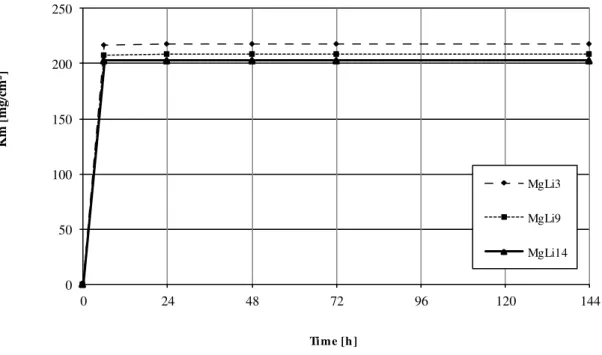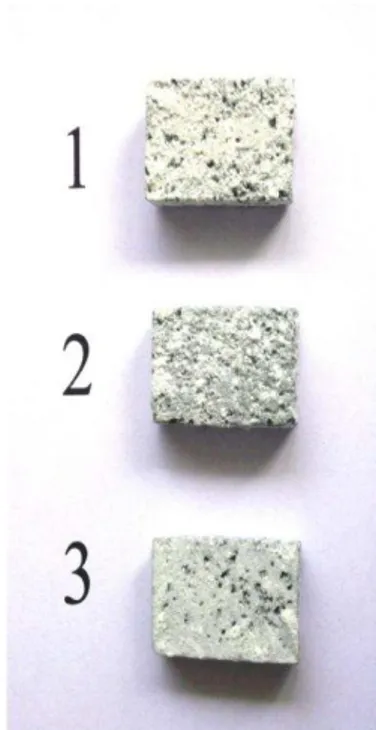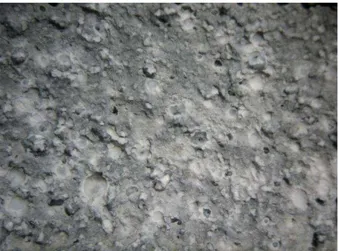A R C H I V E S
o f
F O U N D R Y E N G I N E E R I N G
Published quarterly as the organ of the Foundry Commission of the Polish Academy of Sciences
ISSN (1897-3310) Volume 11 Special Issue
3/2011
25 – 28
4/3
A R C H I V E S o f F O U N D R Y E N G I N E E R I N G V o l u m e 1 1 , S p e c i a l I s s u e 3 / 2 0 1 1 , 2 5 - 2 8 25
Studies of corrosion behaviour in acid
environment of binary Mg-Li alloys
for plastic forming
A. Białobrzeski
a, b*, K. Saja
a, M. Żmudzińskaa aFoundry Research Institute, Zakopiańska 73, 30-418 Kraków,
b
University of Bielsko-Biała, Willowa 2, 43-309 Bielsko-Biała *Corresponding author. E-mail address: abial@iod.krakow.pl
Received 12.07.2011; accepted in revised form 27.07.2011
Abstract
The article discusses studies and corrosion tests of binary M g-Li alloys for plastic forming examined in an acid medium (5% HCl solution) for the time of 0-144 hours. In short it can be stated that corrosion of the examined M g-Li alloys in 5% HCl solution proceeded in a similar mode in all the studied alloys, regardless of the lithium content.
Keywords: Ultralight M g-Li alloys, Corrosion in acid media
1. Corrosion tests of Mg-Li alloys in
acid medium
The object of corrosion studies were as-cast samples of M g-Li alloys of 30 x 20 x 10 mm dimensions designated as: - alloy no. 1 containing 3,54% Li (monophase hcp alloy), - alloy no. 2 containing 8,15% Li (two-phase alloy; phase
and + eutectic),
- alloy no. 3 containing about 13,9% Li (monophase bcc alloy).
Laboratory tests of the corrosion behaviour of M g-Li alloys were carried out by immersion of samples at ambient
temperature, according to the following standards: PN-76/H-04601, PN-78/H04610, PN EN ISO 16151. The principle of the method consisted in subjecting the samples of M g-Li alloys to the effect of a solution prepared in a laboratory. The immersion test was conducted in 5% aqueous solution of HCl. To prepare this solution, analytically pure chemical reagents and redistilled water were used. The duration of individual measurement cycles was 6 h, 24 h, 48 h, 72 h and 144 h.
26 A R C H I V E S o f F O U N D R Y E N G I N E E R I N G V o l u m e 1 1 , S p e c i a l I s s u e 3 / 2 0 1 1 , 2 5 - 2 8
Fig. 1. Comparison of the results of the corrosion-induced weight loss test carried out for M g-Li alloys in 5% HCl solution – corrosion-induced weight loss Km in time
Fig. 2. Comparison of the results of the corrosion-induced weight loss test carried out for M g-Li alloys in 5% HCl solution – weight loss-related corrosion rate Vm in time
0 50 100 150 200 250
0 24 48 72 96 120 144
S p e ci fi c cor ros ion -i n d u ce d w e igh t los s K m [ mg /c m 2]
Time [h]
MgLi3 MgLi9 MgLi14 0 100 200 300 400 500 600 700 800 900 1000
0 24 48 72 96 120 144
W e igh t los s-re late d cor ros ion r ate V m [mg/ cm
2] 24 h
A R C H I V E S o f F O U N D R Y E N G I N E E R I N G V o l u m e 1 1 , S p e c i a l I s s u e 3 / 2 0 1 1 , 2 5 - 2 8 27
Figures 3-4 show surface condition of samples of the tested alloys after 6, 72 and 144 hours of being immersed in 5% HCl solution.
Fig. 3. Corrosion behaviour of M g-Li alloy samples after 6 h of being immersed in 5% HCl solution
Fig. 4. Corrosion behaviour of M g-Li alloy samples after 72 h of being immersed in 5% HCl solution
Fig. 5. Corrosion behaviour of M g-Li alloy samples after 144 h of being immersed in 5% HCl solution
M acrographic studies were also carried out on the precipitates of reaction products on the surface of the examined alloy samples. Figures 6-8 show selected examples of the surface topography of the examined alloys.
.
28 A R C H I V E S o f F O U N D R Y E N G I N E E R I N G V o l u m e 1 1 , S p e c i a l I s s u e 3 / 2 0 1 1 , 2 5 - 2 8
Fig. 7. Surface topography of alloy 2 sample (after 6 h of being immersed in 5% HCl solution, 7x)
Fig. 8. Surface topography of alloy 3 sample (after 6 h of being immersed in 5% HCl solution, 7x)
2. Summary
Studies of the weight loss-related corrosion of M g-Li alloys show a very large weight loss Km during the first measuring
period (i.e. after 6 hours), reaching from 48,8% to 53,4% - in all the examined samples, as illustrated in Figure 1. This suggests a rapid transition of metal into solution in a short period of time. In subsequent measuring cycles, the weight of the measured test
samples hardly changed. The rate Vm of the weight -loss induced corrosion was the highest during the first 6 hours, reaching the level of 811 - 867 mg/cm2 in 24 hours, as shown in Figure 2. In subsequent measurement periods it decreased, reaching a value of 33 - 36 mg/cm2 in 24 hours after 144 h of the corrosive effect of the medium. The surface condition of the examined alloys indicated an uneven corrosion; the surface of the test samples was coated with a white bloom, numerous pittings were also observed. Summing up, the corrosion of the examined M g-Li alloys in 5% HCl solution proceeded similarly in all the studied alloys, regardless of the lithium content.
Acknowledgements
This article was prepared under Project No. POIG.01.03.01-00-015/09 "Advanced materials and technologies for their
production," and, conducted at the Foundry Research Institute,
Task III. 5.1 Ultralight profiles extruded from the new
magnesium-lithium alloys.
References
[1] A. Białobrzeski, K. Saja, K. Hubner: Ultralight
Magnesium-Lithium Alloys VII International Scientific Conference PAN
“Optimization of Production System in Foundries” Łódź, 11 -13 czerwiec 2007 r.; Archives of Foundry Engineering Volume 7, Issue 3/2007, ss. 11-16, ISSN (1897-3310) [2] A. Białobrzeski, A. Fajkiel, K. Saja. P. Dudek:
Eksperymentalne stanowisko do uzyskiwania stopów
ultralekkich; Innowacje w Odlewnictwie Cz.I. Instytut
Odlewnictwa Kraków, 2007 ISBN 978 88770-26-5 str. 35-39 [3] A. Białobrzeski, A. Fajkiel, M . Warmuzek, P. Dudek, K. Hubner, K. Saja: Nowa generacja materiałów na bazie
aluminium i magnezu. Cz.I. Stopy ultralekkie na bazie
magnezu i litu. ; Innowacje w Odlewnictwie Cz.II. Instytut
Odlewnictwa Kraków, 2008 ISBN 978 88770-26-5 str. 31-37 [4] A. Białobrzeski, K. Saja: Experimental stand for melting and
casting of ultralight Mg-li alloys; Archives of Foundry
Engineering Volume 11, ISSUE 3/2011; Gliwice, ISSN (1897-3310) str. 17-20
[5] A. Białobrzeski, K. Saja: Ultralight magnesium-lithium
alloys for plastic working; Archives of Foundry Engineering;


